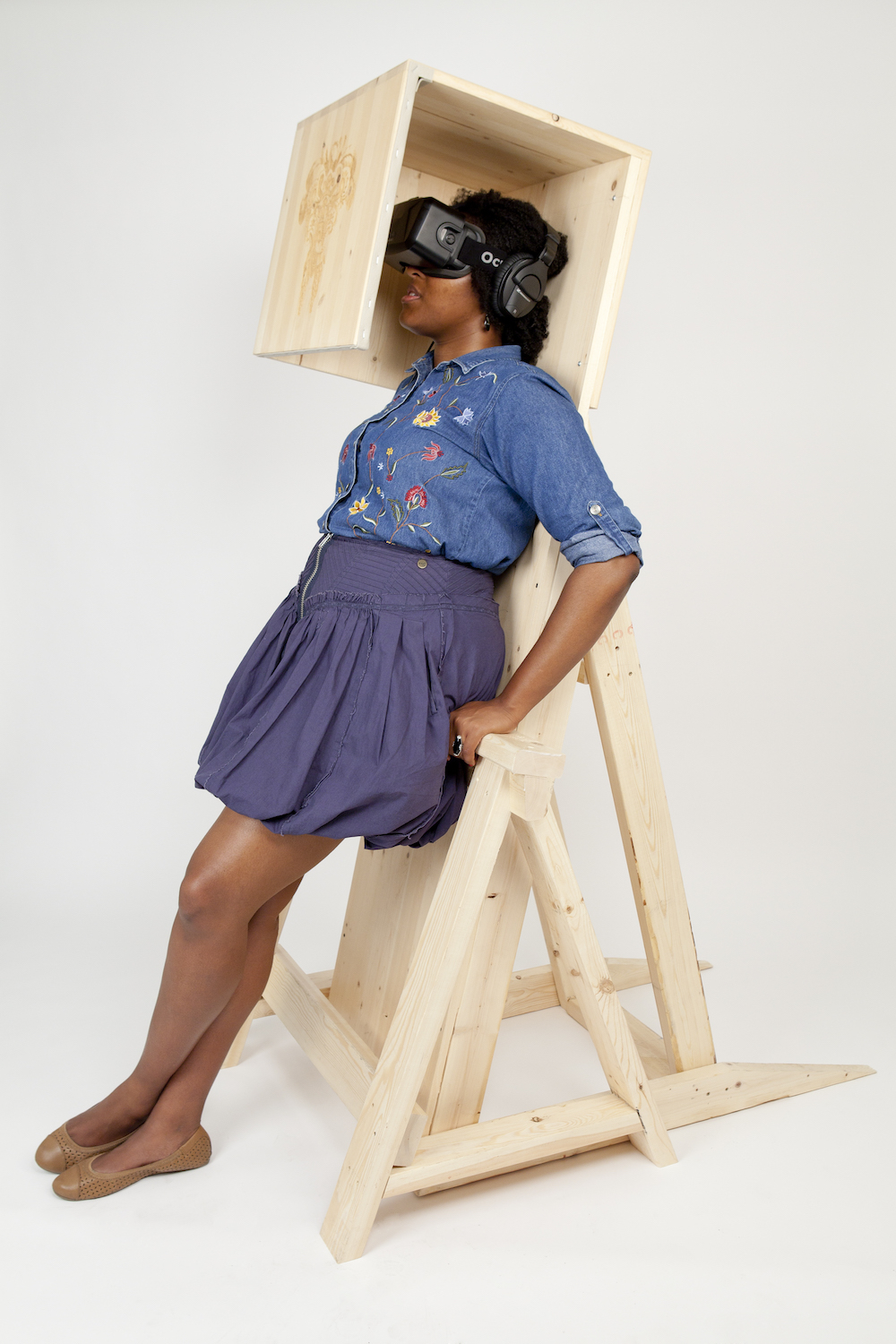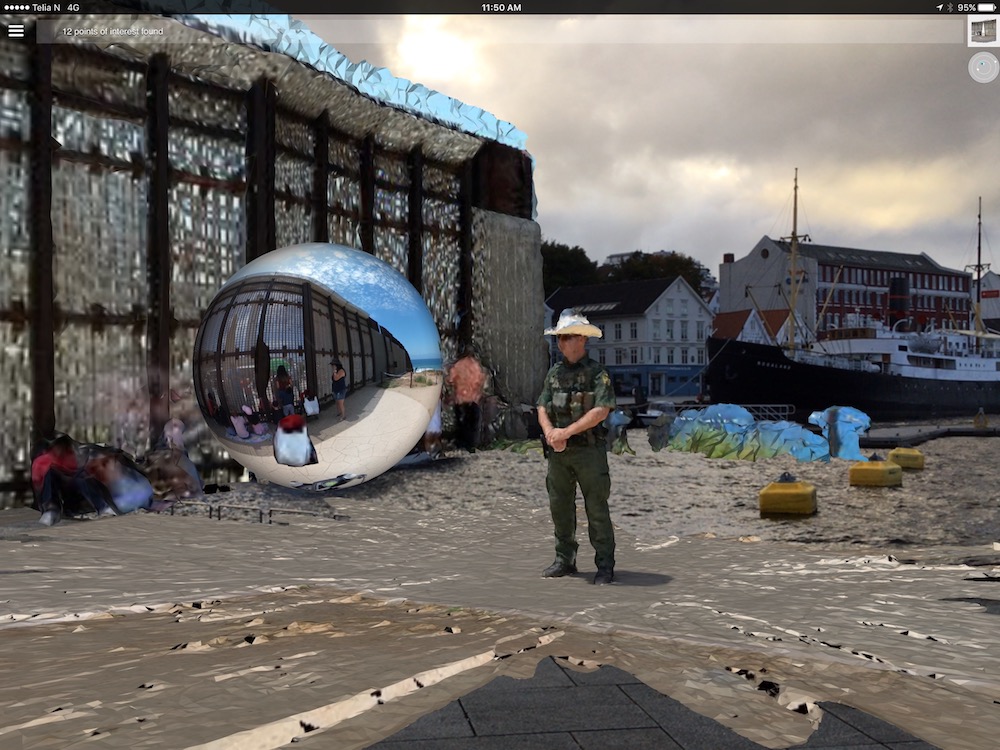
In the middle of the Norwegian harbour town Stavanger, I’m standing looking up at the US-Mexico border. Its muddy, pixellated surface is terrifying and unforgiving on the States side of the wall which towers above me. A US border guard stands not far away, holding a rifle, but wearing sunglasses and a dorky hat. Of course, none of it is real —or, at least, not as real as the cruise ships and brightly painted wooden houses lining Stavanger’s harbour, these still remain once I put the artwork’s iPad down and return to a reality that is not augmented by this digital, geo-located piece.
“The obvious point, but one that is worth repeating: migration is easy for some, dangerous and unwelcoming for others.”
John Craig Freeman’s work Virtual US-Mexico border was commissioned for the Screen City Biennial that takes place around the Norwegian harbour until 31 October. Entitled Migrating Stories, the festival of moving images addresses migration as a condition of contemporary culture, attempting to draw together the threads of displacement and alienation within art—whether that refers to people moving across geographical borders or to the viewer entering different mediums. For example, in the experience of a virtual “buffer zone” between the USA and Mexico, geo-located here in Stavanger, there are two types of migration at play. The first is represented by the huddled virtual family I can walk around in 3D, who stretch a finger through the hole in the wall—in the real world, these migrants to the US would only be allowed to see their family at specified visiting times. The second is my own migration, from the north of Europe, via the virtual, into this liminal space: a stopgap between reality and virtuality but also between countries.

It’s not the only time my senses are dislodged for Screen City, which places the various new-media artworks throughout the city’s public spaces, including the exterior of the concert hall and interior of a group of shipping containers. In Duncan Speakman’s It Must Have Been Dark By Then, which takes place through an interactive mobile app and printed book, I am led through an interactive soundscape that recreates the artist’s voyage across three different places in the world, each the current location of shifting geographical phenomena. Taking place entirely in audio and the app’s empty map, the work helps me create my own psychogeographical journey around the city, through apocalyptic endpoints of encroaching desertification (Tunisia), rising tides (Louisianan swamps) and dwindling populations (Latvia). In some ways, it’s the very opposite of a site-specific work (such as Freeman’s geo-located border). The effect is entirely virtual but has no visual elements, a deft move which allows the person experiencing the work a somehow deeper access to the city around them, as well as the into art work’s nuanced journeys.

Meanwhile, in Olivia McGilchrist’s work Jonkonnu/Gens Inconnu (2015), housed in a shipping container just around the docks, my leaning body is implicated in a wooden contraption, intended to make me feel ill at ease as I put on a virtual-reality headset that sends me into a room with three films playing: an impressionistic documentary of the Jonkonnu carnival in Jamaica, where McGilchrist grew up to a French mother and Jamaican father. The three screens take us through the costumed dancers’ revelry, alongside car-crammed roads, the swirling sounds of drums and neon visual effects reminding us that this space is virtual, it is liminal. McGilchrist explained that the wooden contraption is intended to put her (presumptively North American) audience out of their comfort zone—to remind them that this dance performance of these costumed black bodies sits awkwardly in the context of its colonial past and indeed, for her as an artist, in the context of mixed cultural identity. For her, virtual reality offers a complication of historical representations of local carnival customs in Jamaica that have tended towards exoticization. Reminding the viewer not to get too comfortable helps us take a step back from voyeurism.

Boundaries, after all, have different valences depending on who you are. Privilege makes borders invisible to some people. In the talk Aesthetics of Repair as part of the festival, Maeve Connolly points to the difference between “internationals” and “foreigners”—while “internationals” glide over boundaries, for example, “foreigners” struggle to move globally. The obvious point, but one that is worth repeating: migration is easy for some, dangerous and unwelcoming for others. And yes, this is about race. This is particularly evident in Christa Joo Hyun D’Angelo’s Past Present Tense (2014-15) that is presented in the accompanying online exhibition. The video interviews German people of colour, laying bare the reality that, while white migrants (like myself, I might add) are welcomed into German society with relative ease, many who are racially othered are treated as intrinsically non-German, no matter if their passport or language skills say otherwise.
“While our international borders seem mired in a hopeless battle of “us” vs “them”, the boundaries of the virtual world attempt to offer a democratic access to new artworks.”
While in some ways stories of migrants are more visible than ever, we often lack the visualization (as Sven Lütticken puts it) of migrant stories, even if we literally see their faces. New media, particularly in the curatorial setup of Screen City, is often seen as offering a lens for more experiential narrative visualization. And in places, it does. Yael Bartana’s video, Tashlikh (Cast Off) (2017) offers a chance to move through the histories of persecutory migration via the objects that represent this experience. Appearing to fall through water, or perhaps a celestial infinity, the objects in the video refer to the motion of migration, and the wrenching of that journey, even though the faces of the people the objects belong to are not on show. Similarly Dana Levy’s three-screen video, This Was Home (2016), is a dive through her family’s diasporic past. The artist, her father and grandfather each return to the homes they grew up in (the USA, Egypt and Poland, respectively). Her father, who grew up in Egypt before moving to Israel, expresses something of this strangeness when he explains: “Egypt is the only place I never had an accent.” In the hull of the MS Sandnes boat, her film is juxtaposed with Matti Aikio’s Nomad Talk (2011), an attempt to understand the philosophies of nomadism (if such a thing even exists).

Movement across borders is about access—access for the right people IRL, for the right devices in the virtual. While our international borders seem mired in a hopeless battle of “us” vs “them”, the boundaries of the virtual world attempt to offer a democratic access to new artworks: “the promise of a new way of seeing”, as McGilchrist puts it. The screens are beginning to dissolve into new liminal realities and yet they are forever at risk of replicating physical ones. We might find ourselves somewhere new and digital but our bodies are still here, on the right side of the US/Mexican border which is, and always will be, the side of the wall that means you can travel between both.






